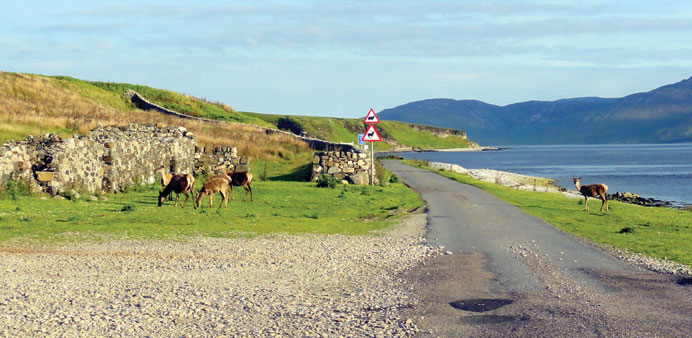The sole road from from Feolin to Tarbert on the Scottish island of Jura. Animals tend to take precedence over cars, even on the asphalt itself. Photograph: Brigitte Geiselhart
By Brigitte Geiselhart
The sea is rough, the clouds are low and a force-5.7 gale is blowing. “It’s no problem. Every day is different,” says John MacLeod, third officer on board the Caledonian-MacBrayne ferry.
The man knows what he’s talking about. Five times a day, seven days a week, he plies the route between the Scottish mainland and the island of Arran, carrying up to 1,000 passengers and 100 cars a trip. Arran is one of a group of islands off Scotland’s south-western coast that are a favourite destination for vacationers keen on a bit of island-hopping. This is MacLeod’s world.
“This is a dream job for me,” he says. “I have two weeks on duty and then two weeks off, and so it goes on back and forth the whole year through.” Asked what is so special about Arran he has no trouble answering. “We have everything — mountains, valleys, rivers, the sea, and cheeses and chocolate we make ourselves. What more could you want?”
The next day there’s brilliant sunshine and no wind. “Be careful,” Corinna Goeckeritz, a German conservationist, advises adventure-seeking tourists. “The weather can change quickly.” The tourists at Brodick Castle are aiming to hike to Goatfell, the island’s highest mountain at 874m.
Goeckeritz works for the National Trust for Scotland, an agency with the motto, “Keep the nature wild.”
In practical terms, that means hikers are given detailed maps and if necessary a compass, rather than setting out many markers along the trail, which might only serve to lure out vacationers who then overestimate their hiking abilities.
The mountain peak is often shrouded in thick fog, and sometimes you can hardly see your own hand. Hikers are also advised to carefully study the trail along the challenging route, so that on their return descent they are spared any unpleasant surprises.
The climb is well worth the effort. And if one is fortunate and the veil of fog lifts at the right moment, then all the better, for the view of the bay of Brodick from the summit is a splendid one, and a moment for back-slapping congratulation: “We did it!”
Other islands are waiting to be explored for a change of scenery and mood. Islay for example. At Loch Guinart on the north-western part of the island, Emily Platt of the Royal Society for the Protection of Birds not only oversees 1,700 hectares of nature preserve, but also the countless birds who come here to nest or to spend the winter.
The rare corncrake is a welcome guest here, as are the chough, the lapwing, the barnacle goose and white-fronted goose. The tally in the course of a year comes to more than 150 species of birds.
Among the few human visitors to Islay are birdwatchers and vacationers seeking the indescribable peace and quiet of the nature trails. Emily Platt’s only explanation for the place’s special atmosphere is simple:
“We are doing precisely what people have done for centuries. We are living according to Nature’s rhythms.”
The ferry ride from Islay to the island of Jura takes all of five minutes. Writer George Orwell loved this patch of the planet — possibly because of its famous whisky, but also probably because he could work here undisturbed.
Things don’t seem to have changed very much since Orwell’s time.
The only drivable road connecting the towns of Feolin and Tarbert is hellishly narrow. Over and over again one sees wild rabbits standing at the edge of the asphalt, or now and then large deer and splendid peacocks.
Cars play only a supporting role in this natural setting. There is no use whatsoever for a car on the tiny island of Gigha which can be reached after a short ferry ride from Tayinloan on the peninsula of Kintyre. The plan for Gigha is to see and enjoy the Achamore Gardens with their exotic trees, huge rhododendrons and azaleas.
Now it’s back to Arran. Ann Hume moved here from the mainland out of love and has now become one of the locals. “You can’t get any closer to Nature, but also to other people than here,” says the former school-teacher.
Asked if she has any yearning for her former life and regular hours job, the answer is quick: “Not even a bit.” — DPA



